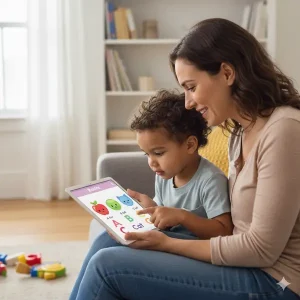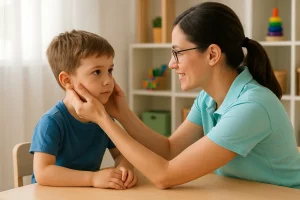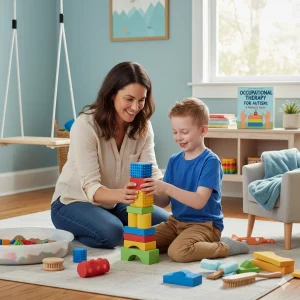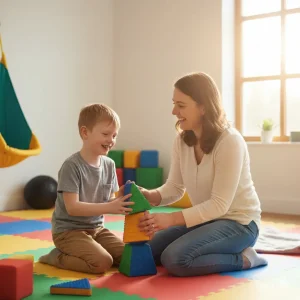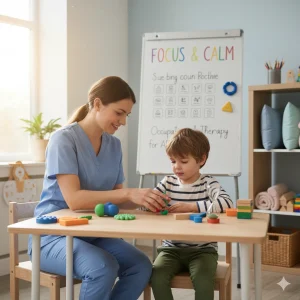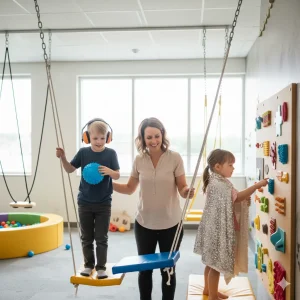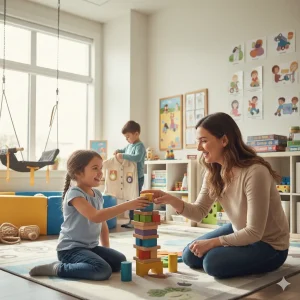How Occupational Therapy Helps 10-Year-Olds Excel in School
By Wellness Hub
Last Updated: October 21, 2025
Does your 10-year-old struggle to keep up with schoolwork—messy handwriting, half-finished notes, endless reminders to “focus”? You’re not alone. Many bright, capable kids find classroom tasks harder than they should be, not because they aren’t trying, but because the skills behind learning—attention, planning, coordination, and self-regulation—haven’t fully clicked yet.
That’s where occupational therapy for 10-year-olds makes a real difference. In simple terms, OT helps children bridge the gap between effort and performance. It turns daily school challenges—writing neatly, staying organized, following multi-step directions—into manageable, confidence-building wins.
An occupational therapist looks beyond grades or behavior; they uncover why tasks feel hard. Maybe pencil control is tiring, visual tracking is tricky, or sensory distractions make focus impossible. With the right strategies, your child can write faster, pay attention longer, and enjoy school again.
What OT Does for 10-Year-Olds in School
Occupational therapy for 10-year-olds helps children strengthen the foundation skills they need for learning and independence. In simple terms, OT supports better handwriting, attention, planning, and sensory regulation—so schoolwork feels easier and more enjoyable. By improving how children focus, organize, and manage daily classroom tasks, OT helps them participate confidently, complete homework independently, and enjoy learning again.
Also read: OT for 5-Year-Olds: Writing & Dressing Made Easy with Early Support
Signs Your 10-Year-Old May Be Struggling (And It’s Not “Laziness”)
If your 10-year-old often seems “lazy” or unmotivated in school, it might not be about effort at all. Many children genuinely want to do well but face underlying challenges that make daily classroom tasks harder. Recognizing these early red flags can help you step in with the right support—before frustration or low confidence take hold.
Here are some common signs that your child may need a little extra help from occupational therapy or school-based supports:
- Handwriting struggles: Letters are uneven, too large or too small, or your child complains their hand hurts while writing. Homework may take much longer than expected.
- Organization challenges: Constantly losing pencils, forgetting homework, skipping steps in multi-part assignments, or needing frequent reminders to start or finish work.
- Attention and self-regulation issues: Difficulty staying seated, easily distracted by noise or movement, emotional meltdowns after school, or “zoning out” during lessons.
- Visual and fine-motor problems: Trouble copying from the board, lining up numbers in math, cutting neatly, or manipulating small items like buttons and zippers.
- Self-care and independence concerns: Struggles with tying shoelaces, managing lunch items, or keeping their desk space tidy and ready for lessons.
How Occupational Therapy Improves Academic Skills
Every parent wants their child to do well in school—but sometimes, it’s not about intelligence or effort. It’s about how the child’s body and brain work together to complete everyday school tasks. This is where occupational therapy (OT) steps in. OT bridges the gap between a child’s developmental skills and academic performance, helping learning feel more natural and less stressful.
School-based occupational therapy focuses on function: handwriting, note-taking, test stamina, organization, and emotional regulation. Rather than teaching subjects, OTs build the foundation that supports learning—so your child can write clearly, sit longer, focus better, and carry out classroom routines independently.
Here’s how OT turns small developmental gains into big academic wins:
- Improves handwriting legibility and written expression for clearer, faster work.
- Strengthens planning and organization, helping your child manage assignments and remember steps.
- Builds independence—from packing their backpack to finishing homework on time.
- Enhances attention and self-regulation, helping them stay calm and focused.
- Sharpens visual-motor and perceptual skills for reading, math, and copying tasks.
- Teaches practical strategies children can use on their own—at school, at home, and during exams.
Handwriting & Written Expression
Handwriting remains one of the biggest academic hurdles at this age. Occupational therapy for handwriting focuses on developing the strength, posture, and control needed for smooth, pain-free writing.
Here’s how OTs help step by step:
- Build posture and core stability – A stable base helps the hands move with better precision.
- Correct pencil grasp and pressure – Therapists teach comfortable, controlled holds.
- Work on letter formation and spacing – Using adaptive paper, visual cues, and fun tracing tasks.
- Practice timed writing – Builds endurance and speed without sacrificing neatness.
- Include breaks and hand exercises – Prevents fatigue during longer tasks.
Studies show that targeted handwriting interventions and fine-motor exercises can significantly improve both speed and legibility, making writing more automatic and less tiring.
Read more: Occupational Therapy for 8-Year-Olds: Improve Handwriting & Focus
Executive Function (Planning, Organization, Working Memory)
Ever notice your child forgetting homework steps or misplacing their books? That’s an executive function (EF) challenge. Occupational therapy helps kids develop practical systems that make school life manageable and less chaotic.
Common OT strategies include:
- Creating visual schedules and daily planners for predictability.
- Teaching task chunking—breaking big assignments into smaller steps.
- Using timers and alarms for transitions and focus periods.
- Practicing “pack-my-bag” routines with color-coded folders.
- Building self-talk and checklists to stay on task.
Research by experts like Dawson & Guare shows that structured EF supports improve independence, attention, and homework completion—skills every 10-year-old needs for confidence in class.
Attention & Self-Regulation
Many children can pay attention—just not in the same way adults expect. Occupational therapists teach focus through movement, rhythm, and sensory awareness rather than strict stillness.
Step-by-step OT supports include:
- Scheduling movement breaks and “heavy work” tasks to reset energy.
- Allowing discreet fidget tools with clear rules to manage restlessness.
- Adjusting seating positions—like wobble cushions or therapy balls—for alertness.
- Teaching breathing tools and calm-down kits for emotional control.
Sensory Processing for Calm Learning
Children who seem “overreactive” or “under-responsive” to classroom noise, light, or touch might be experiencing sensory processing differences. OT helps them make sense of those sensations so they can learn comfortably.
Common sensory strategies include:
- Reducing noise and visual clutter in learning spaces.
- Using headphones or seating changes to limit distractions.
- Building predictable routines to avoid overwhelm.
- Incorporating movement or deep pressure to stay regulated.
When sensory input feels safe and predictable, children can focus better, follow instructions, and engage without meltdowns—leading to a calmer, more productive school day.
Visual-Motor & Visual-Perceptual Skills
If your child struggles to copy from the board, align math problems, or track words while reading, OT may address the visual-motor link—how the eyes and hands work together.
OT strategies include:
- Practicing near–far copying to strengthen eye coordination.
- Using graph paper for neater math alignment.
- Highlighting margins or writing zones for better spacing.
- Adding pointer tools or reading strips to improve tracking.
Research shows that improving visual-motor and perceptual skills not only boosts handwriting but also enhances reading fluency and comprehension.
What an OT Evaluation Looks Like (School & Clinic)
If you’re considering occupational therapy for your 10-year-old, the first step is a thorough OT evaluation—a gentle, child-friendly process designed to understand how your child learns, plays, and manages daily school tasks. The goal isn’t to label, but to uncover the skills behind the struggle so the right support can be planned.
Here’s what typically happens during an OT evaluation, whether in a school setting or a private clinic:
Referral & Background Review
It begins with a referral—often from a teacher, pediatrician, or concerned parent. The therapist reviews your child’s medical and academic history, teacher feedback, and past progress reports to understand overall performance and daily challenges.
Classroom or Functional Observation
In school-based OT, the therapist observes your child during real classroom tasks—writing, organizing materials, or following directions. This step highlights how skills like attention, posture, and motor coordination affect participation. In a clinic, similar tasks are recreated using play-based activities or tabletop exercises.
Standardized Testing & Informal Assessments
Your child may complete age-appropriate standardized tests that measure fine motor control, visual-motor integration, sensory processing, and executive skills. Informal games or puzzles are also used to gauge how they plan, focus, and adjust to new tasks—all in a friendly, low-pressure way.
Goal Setting & Collaboration
Based on findings, the OT sets functional goals—for example, improving handwriting endurance, staying on task for longer periods, or organizing materials independently. These goals align closely with classroom participation and real-life needs rather than abstract scores.
Report & Recommendations
Finally, you’ll receive a detailed report summarizing your child’s strengths, challenges, and personalized recommendations. Expect clear home and school strategies—like short movement breaks, pencil grip supports, visual schedules, or task simplification steps you can start right away.
Therapy Plan: Frequency, Goals, and Measuring Progress
Once your child’s occupational therapy evaluation is complete, the next step is creating a personalized therapy plan—a roadmap that outlines how your child will grow, how progress will be tracked, and how school and home can work together. For parents, understanding this plan is key to knowing what to expect and how success is measured.
A good OT plan is goal-driven, structured, and flexible. It focuses on what truly matters for your child’s daily functioning—not just test scores, but confidence, independence, and participation.
How an Occupational Therapy Plan Works
SMART and Functional Goals
Your therapist will set SMART goals—Specific, Measurable, Achievable, Relevant, and Time-bound.
These are not vague targets like “improve handwriting” but specific ones such as “write a five-sentence paragraph with correct spacing and posture in 10 minutes.”
Session Frequency & Model
Therapy can happen in two formats:
- Pull-out sessions: One-on-one sessions outside the classroom to work on targeted skills.
- Push-in sessions: The OT joins your child in the classroom to support skills in real time.
Frequency typically ranges from 1–2 sessions per week, depending on the child’s goals and school setting.
Ongoing Data Collection
Progress isn’t judged by observation alone. Therapists use timings, rubrics, and work samples to track growth objectively. For example, they might record how long it takes your child to finish a writing task or how often they need reminders to stay on task.
Collaborative Adjustments
As your child improves, goals are reviewed and updated. The plan may shift focus—from improving grip strength to building handwriting stamina, or from self-regulation to organization skills. This ensures therapy always matches classroom demands and developmental milestones.
Example of an OT Therapy Plan
| Goal | OT Strategy | Progress Measure |
|---|---|---|
| Improve handwriting legibility | Use pencil grips, visual writing guides, and hand-strengthening games | Compare work samples every 4 weeks for spacing, pressure, and letter formation |
| Increase classroom focus | Add sensory breaks, breathing tools, and fidget protocols | Observe time-on-task; record distractions per 10-minute interval |
| Organize school materials | Teach backpack checklist and color-coded folders | Track forgotten items weekly; parent/teacher feedback |
| Build self-regulation | Practice movement breaks and calm-down kits | Behavior tracking sheets; self-reflection charts |
| Boost endurance during written tasks | Incorporate posture exercises and timed practice | Monitor completion time and fatigue levels |
When to Seek OT & How to Talk to Your Child’s Teacher
As parents, you know your child best. If you’ve noticed ongoing school struggles — messy handwriting, focus issues, constant frustration, or poor organization — it might be time to explore occupational therapy (OT). The earlier you act, the easier it is to support your child before these challenges affect their confidence or love for learning.
Recognizing when to seek help and knowing how to approach your child’s teacher can make all the difference. Here’s a simple step-by-step guide to help you take the next move with clarity and confidence:
Track What You See at Home
Before reaching out, take note of specific examples — incomplete homework, complaints of hand pain, emotional meltdowns after school, or constantly misplaced materials. Keep short notes or photos of schoolwork samples that show difficulty with handwriting, spacing, or attention. This helps teachers and therapists see patterns clearly.
Start the Conversation with the Teacher
Reach out via a concise email or short meeting request. Keep your tone collaborative, not critical. You might say, “I’ve noticed my child struggles with handwriting and organization. Have you seen similar challenges in class?”
Teachers often appreciate your insight and can share valuable classroom observations that strengthen your case for support.
Myths vs. Facts About OT for School Success
When parents first hear about occupational therapy (OT), they often picture toddlers stacking blocks or preschoolers learning to hold a crayon. But OT is much more than that — it’s about helping children of all ages, including 10-year-olds, develop the skills they need to thrive in school and daily life. Unfortunately, a few common myths and misconceptions can delay families from seeking help that could make a real difference. Let’s clear them up.
Myth 1: “Occupational therapy is only for little kids.”
Fact: OT grows with your child. While early childhood therapy focuses on play and motor skills, school-aged OT targets handwriting, executive function, attention, and organization — all essential for academic success. As children mature, their “occupations” shift from play to learning, friendships, and independence. Occupational therapy adapts to those changing needs.
Myth 2: “OT just means handwriting practice.”
Fact: Handwriting is only one piece of the puzzle. Occupational therapy supports fine-motor skills, planning, focus, and sensory regulation — the hidden foundations behind classroom learning. Whether it’s managing materials, staying on task, or handling frustration, OT helps children build the skills that make learning easier and more enjoyable.
Myth 3: “My child will outgrow these challenges.”
Fact: Some kids do catch up naturally, but others need guidance to develop specific skills. Without support, small challenges in handwriting, attention, or organization can become bigger obstacles in middle school. Early intervention through OT can prevent these issues from impacting confidence and academic growth later.
Myth 4: “Therapy will make my child feel different or singled out.”
Fact: Today’s OTs work discreetly and supportively, often within the classroom setting. Many students see OT as part of their normal school day — just like reading or math help. Sessions are designed to be positive, engaging, and empowering, helping children feel capable, not different.
Myth 5: “OT can’t really change behavior or focus.”
Fact: Research shows that sensory and self-regulation strategies taught in OT can significantly improve attention, task completion, and emotional control. By understanding how the brain and body respond to stimuli, therapists help children create their own calming or energizing strategies — skills they can use for life.
Safety, Ethics, and How OT Protects Dignity
When you trust a professional to work with your child, safety, respect, and dignity come first. Occupational therapy (OT) is built on a strong ethical foundation that ensures every child is treated with compassion, inclusion, and fairness. Whether your child is receiving school-based or clinic-based OT, therapists follow strict professional standards to protect their emotional and physical well-being.
At its heart, occupational therapy is child-centered — meaning your child’s comfort, preferences, and abilities guide every decision. Therapists don’t just teach skills; they empower children to participate, make choices, and feel proud of their progress.
Here’s how OT upholds safety and dignity at every step:
1. Child-Centered Goals and Collaboration
Every goal is designed around your child’s unique needs, strengths, and priorities. Therapists work closely with parents, teachers, and sometimes the child themselves to set functional, realistic goals that feel meaningful — not forced.
2. Respect and Consent
Ethical OTs always seek informed consent from parents (and assent from the child) before starting interventions. Children are encouraged to speak up if they’re uncomfortable. This teaches self-advocacy while ensuring therapy stays positive and respectful.
3. Use of Age-Appropriate, Safe Tools
From adaptive scissors to sensory toys, all materials used in OT are chosen for safety, developmental suitability, and purpose. Activities are adjusted for comfort — ensuring that therapy feels fun and engaging, never stressful.
4. Inclusion and Least-Restrictive Supports
Occupational therapy values inclusion — helping children succeed alongside their peers. Following the “least restrictive environment” principle from IDEA (Individuals with Disabilities Education Act), school OTs work to adapt the environment rather than isolate the child. The focus is on participation, not separation.
5. Upholding Professional Ethics and Privacy
According to the AOTA Code of Ethics, therapists must act with integrity, maintain confidentiality, and respect every child’s dignity regardless of ability, background, or diagnosis. They are accountable for creating safe, encouraging spaces where children can grow at their own pace.
6. Promoting Confidence, Not Comparison
A truly ethical therapist celebrates small wins and helps children see their own progress without comparison to others. Every step forward — whether it’s improved handwriting, better focus, or more independence — is recognized and valued.
Conclusion
In occupational therapy, your child’s safety, dignity, and confidence always come first. Every session is built around your child’s unique needs, using fun, age-appropriate tools and inclusive strategies that make learning feel natural. OTs follow strong ethical standards, ensuring respect, consent, and privacy at every step. The goal isn’t just skill improvement—it’s helping your child feel capable, included, and proud of their progress. By working with a qualified, caring occupational therapist, you’re giving your child the support to grow with confidence—at home, in school, and in life. OT empowers kids to thrive, not just cope.
Frequently Asked Questions:
1. What does an occupational therapist do for a 10-year-old at school?
An OT helps your child succeed in daily school tasks—writing, organizing, focusing, and staying calm. They assess barriers, teach strategies, and suggest classroom tools like pencil grips, timers, or movement breaks. The goal is functional independence: work that’s clearer, faster, and less stressful.
2. How do I know if my child needs OT or just more practice?
If extra practice doesn’t change handwriting, organization, or focus, or if your child avoids tasks or feels frustrated, an OT screen can help. OTs look for underlying skill gaps (posture, visual-motor, planning) and match supports to classroom demands—so effort finally leads to progress.
3. Will OT replace tutoring or medication?
OT isn’t a replacement; it’s a complement. Tutors target subject knowledge. OT targets the skills and strategies that let your child access learning—like planning, stamina, and sensory regulation. For medication questions, speak with your pediatrician; many families use a combined approach.
4. How long before we see progress?
Parents often notice early wins within a few weeks—less complaint, better spacing, improved routines. Bigger changes (legibility, speed, independence) can take a few months. Progress is faster when home and school use the same strategies and when goals are specific and measured.
5. Is school-based OT only for handwriting?
No. School OT supports participation in all classroom activities: organizing materials, copying from the board, listening with focus, self-regulation, and managing transitions. Handwriting is common, but executive function and sensory regulation are equally important at this age.
6. What happens during an OT evaluation?
The OT reviews history, watches your child in class, and uses standardized tests and real work samples. You’ll get a report with functional goals and strategies for home and school. Good evaluations make the plan crystal clear and easy to follow.
7. How often do kids go to OT?
It depends on goals and setting. Some children receive short, targeted support in school; others attend weekly clinic sessions. Plans should include specific strategies for teachers and parents so improvements generalize beyond the session.
8. Can OT help with attention without medication?
OT supports attention through environment, tools, and routines—movement breaks, seating options, fidgets with rules, visual schedules, and task chunking. These reduce overload and build self-management. Medical decisions belong to your pediatrician; OT focuses on functional strategies.
9. What tools actually help with writing?
Common tools include pencil grips, slant boards, highlighted lines, graph paper for math, and timer-based work bursts. Tools are most effective when paired with posture work, letter formation practice, and planned breaks recommended by your OT.
10. How do I start the process with school?
Document concerns with dated examples, email the teacher, and request an OT screen or full evaluation. Ask for specific goals tied to classroom tasks. Schedule a follow-up date to review progress and adjust supports if needed.
About Author:
Sonali Sharma, Occupational Therapist
Sonali Sharma is a skilled Occupational Therapist at Wellness Hub, with over three years of experience in supporting children with developmental, behavioral, and learning challenges. She holds a Bachelor’s in Occupational Therapy (BOT) from Amity University and has worked with leading institutions such as NIMHANS Bengaluru and ESIC Hospital Faridabad.
At Wellness Hub, Sonali provides online occupational therapy sessions tailored to each child’s needs. She specializes in pediatric therapy, autism support, sensory integration, and developmental skill-building, helping children strengthen motor skills, improve focus, and become more independent in daily life.
Her therapy style is child-centered, play-based, and evidence-driven—making sessions both effective and enjoyable for kids. Sonali also equips parents with practical home therapy strategies to extend progress beyond sessions.
Passionate about empowering families, Sonali believes in creating a nurturing space where children can thrive while parents feel supported every step of the way.
Book your Free Consultation Today
Parent/Caregiver Info:
Client’s Details:
* Error Message

